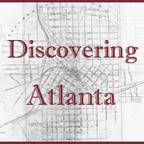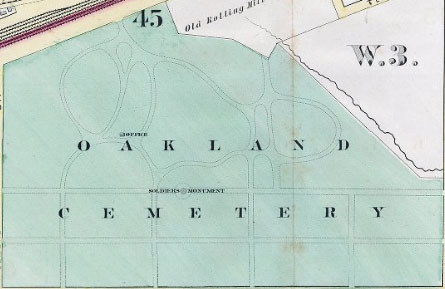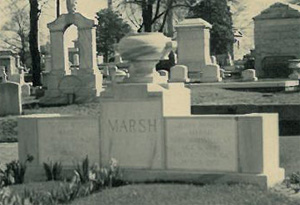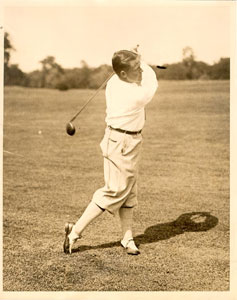by Sara Logue, Research and Public Service Archivist, MARBL
 Early on in Atlanta’s history, it was determined that the growing town was going to need a space to bury its citizens. In 1850, six acres of land were purchased and set aside for the purpose of a public cemetery. By 1867, however, the cemetery grew to 48 acres due to the high number of Civil War casualties in and around Atlanta. Oakland Cemetery was designed as a rural garden cemetery allowing for citizens of the city to take advantage of a beautiful outdoor space while visiting with their late friends and relatives. Today the space is frequented for both tours of Atlanta history, and as a way to visit some of the city’s more famous inhabitants.
Early on in Atlanta’s history, it was determined that the growing town was going to need a space to bury its citizens. In 1850, six acres of land were purchased and set aside for the purpose of a public cemetery. By 1867, however, the cemetery grew to 48 acres due to the high number of Civil War casualties in and around Atlanta. Oakland Cemetery was designed as a rural garden cemetery allowing for citizens of the city to take advantage of a beautiful outdoor space while visiting with their late friends and relatives. Today the space is frequented for both tours of Atlanta history, and as a way to visit some of the city’s more famous inhabitants.

Oakland Cemetery from Map of Wards 3&4, City Atlas of Atlanta, GA: From Actual Surveys and Records, Manuscript, Archives and Rare Book Library,Emory University
Interestingly, the cemetery was originally purchased on land that was considered to be in the country at the time. As Atlanta has grown, the cemetery now finds itself directly in the middle of the city. The cemetery fell into disrepair in the early 20th Century, but 1976 brought about both a placement on the National Register of Historic Places, as well as the establishment of the Historic Oakland Foundation. While we don’t have much info specifically on the cemetery, you will find buried in Oakland many important citizens whose papers are part of MARBL‘s collections.
Oakland cemetery has come to be the final resting place for a number of Atlanta’s prominent officials from mayors to businessmen. As mentioned, a large number of Civil War soldiers, both Confederate and Union, have found their way there after falling on the battlefield. While a number of graves are marked for these soldiers, a great many more are unknown.
Notable persons buried in Oakland Cemetery whose manuscript collections are at MARBL include:

Signature of Andrew Jackson Neal, Andrew Jackson Neal Papers, Manuscript Archives and Rare Book Library, Emory University
Andrew Jackson Neal was a lieutenant in the Marion Light Artillery during the Civil War. His numerous letters home to his parents and sister, which are housed at MARBL, illuminate the life of a soldier in the Confederate army. He died after being shot in the Battle of Peachtree Creek in 1864 and was interred alongside his brother James, also a soldier.

Headstone of Margaret Mitchell Marsh, Photograph from Margaret Mitchell Papers, Manuscript, Archives and Rare Book Library, Emory University
Margaret Mitchell is one of Atlanta’s most celebrated literary icons. Her novel, Gone With the Wind, was written in Atlanta and features prominently the city’s destruction during the Civil War. MARBL has a Margaret Mitchell collection which is home to a number of letters, particularly during the time immediately following the publication of the novel and how she dealt with its immense popularity as well as its criticism. Margaret is buried under the Marsh headstone with her husband.

Bobby Jones golfing, Bobby Jones Papers, Manuscript, Archives and Rare Book Library, Emory University
Bobby Joneswas a golfer who is the only person to have won the Grand Slam and who also planned the Augusta National Golf Club in Georgia. Among our collection of his personal papers and memorabilia are audiovisual materials of his 1930 Grand Slam run, programs for golf tournaments, a bronzed shoe, and a large number of photographs including those from his childhood. Jones died in 1971, and is buried in Oakland with his wife Mary.
A walk through Oakland Cemetery will give you a good sense of who inhabited Atlanta from its earliest days, and how a cemetery takes shape in a rapidly expanding city which has to take into consideration not just the housing of its living citizens, but also of its dead.
For more information on the Oakland Cemetery, its history and inhabitants, visit: The Historic Oakland Foundation website.
